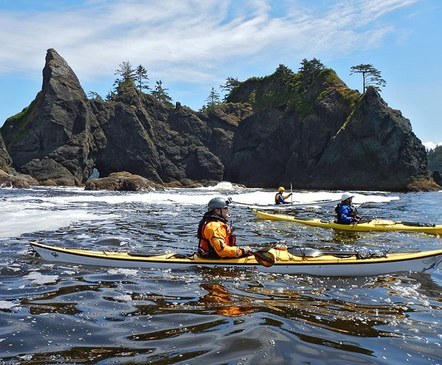Sea Kayaking
The Mountaineers offers a variety of sea kayaking trips on lakes, sounds, inlets and oceans.
Sea Kayak Trips
Participants are required to meet a minimum skills prerequisite, usually assessed through course participation or equivalency.
|
Prerequisite |
 |
 |
|---|
If you are an experienced sea kayaker and wish to apply for our basic sea kayaking equivalency, please fill out an equivalency application.
Difficulty Ratings
The Mountaineers sea kayak trips use the following difficulty ratings. For trips that are more technical or involved, leader's permission may be required to participate.
| Trip Rating |
Geography | Hydraulics | Routes | Acceptable Conditions | Skills |
| Sea Kayak I | In areas protected from waves by nearby landforms in case of wind. | Insignificant currents. | Day trip near shore. | Calm. | Ability to swim. Except with leader's permission: (a) previous experience required on trip smore than 5 nm and (b) previous experience capsizing and wet exiting (or be willing to learn how before the trip). |
| Sea Kayak II | Fetch less than 10 nm unless it is generally possible to land and walk out. Crossings <1/2 nm except for very protected trips. | Maximum predicted current up to 1 kt. | Either has protection or intermittent places to get out. | Generally try to avoid choppy water and/or winds above 10 kt. | Participants must have practiced assisted sea kayak rescue techniques. |
| Sea Kayak III | Crossings up to 2 nm wide and/or fetches longer than 10 nm. |
Maximum predicted current up to 2 kt. |
May involve crossing eddy lines and tide rips. | Generally will not start out in whitecaps, but be prepared for paddling into waves large enough to wash over the deck, and be comfortable paddling in at least 10 kt winds. | Conditions may require bracing skills. Previous group and self-rescue practice (both as rescuer and rescuee). |
| Sea Kayak IV | Crossing up to 5 nm. | Predicted currents may be more than 2 kt, but less than slowest paddler's top speed. | May cross strong eddy lines, tide rips, and upswellings. | May include steep waves and swells. Be comfortable paddling in 15 kt winds. | Conditions may require anticipatory leaning, reflexive bracing, stern rudder with paddle, and the ability to read moving water. Familiarity with charts and navigation. |
| Sea Kayak V | Crossing more than 5 nm, but less than 3 hours' paddling time at the speed listed with the trip. Exposed ocean coasts are included when precautions are taken. | Currents may be faster than group can paddle against. | May include landing and launching in surf. | For groups prepared to knowingly set out in rough weather, whitecaps, and fast currents. | Trip members must have tested their skills in rough conditions, know their limits, and be self-reliant in the event of separation from the group. The ability to Eskimo roll is highly recommended as conditions can make sea kayak rescues difficult. Rescue practice with the kayak and equipment used on this trip. |
| Sea Kayak VI | Trips combining a long fetch with stretches where safe landing may be difficult or impossible for most of the day. | Exposure to hazards at any other levels taken to extremes. | Exposure to hazards at any other levels taken to extremes. | May only be negotiable with favorable conditions. Kayak rescues may not be possible. | Extensive experience and skill including kayak surfing and rolling are required. |
|
The rating system is a general guide; the highest rating of any factor is usually used to rate the trip. Plus or minus signs can be used to further differentiate the levels. For example, a minus sign could be used for a trip which technically gets a given level, but is on the easy side of that level. An asterisk designates training trips open to paddlers new to that level. The distance to be paddled and the expected paddling speed should be listed, but do not affect the trip level. Due to extra risk, the following factors increase the trip rating a half level:
|
SEA KAYAKING PACEPaddlers need to stick together on the water, even closer than hikers on land. Knowing the planned sustained flatwater pace of the trip, as well as the pace you can travel, is critical.
|
Required Equipment
These seven essentials plus The Ten Essentials are required on all sea kayaking trips. All but the whistle and clothing should be provided with any kayak rental.
- Floatation in both ends of the kayak
- U.S. Coast Guard approved Personal Flotation Device (PFD)
- Paddle
- Spray skirt
- Bilge pump with flotation
- Self-rescue paddle float
- Waterproof whistle
- Appropriate clothing for the conditions encountered seasonally
